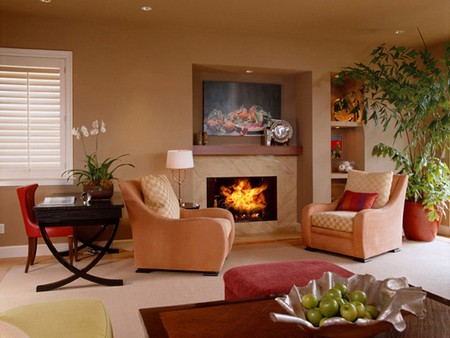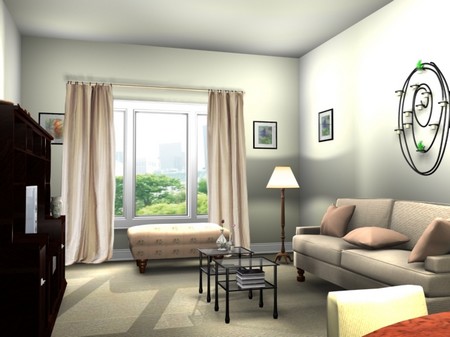Best Way to Create an Allergy-Free Living Room
The living or family room is normally where the whole family can relax in comfort. Depending on personal taste, it may be carpeted or have a hard-surface floor perhaps covered with rugs. Furniture will probably include upholstered sofas (couches) and chairs and scatter cushions or pillows. There is likely to be a television and a sound system. On the walls, there will be paintings, prints, or photographs – perhaps even wall-hangings. Ornaments will be in display cabinets, on shelves around the room, or arranged on the mantlepiece. Some older homes may still have their original open fires. Although this sounds very pleasant, there are factors that could make life less than comfortable for allergy sufferers.
Chief among these are the type of flooring and the presence of soft furnishings, including upholstered sofas or couches and curtains. Very important, too, is whether or not a pet is allowed access to the room, the ease with which the arrangement of the room permits regular cleaning, and the type of materials used in the construction of cabinets or shelves.
You must first identify the allergy sufferer’s specific needs before you can undertake effective controls. If, for example, sensitivity to mite allergen is a crucial element in a person’s symptoms, then mite control will be the key to adapting the room. However people with animal allergies need to reconsider the place of any animals in the home, while sufferers from mould allergies may be helped by preventing mould growth due to condensation.
Furniture
- Choose furniture that fits to the ceiling.
- Avoid open shelves. Bookshelves should have glass doors.
- Air new board-based furniture to reduce levels of formaldehyde gas.
Sound and TV equipment
- Store electric equipment in cabinets.
- Choose a vacuum cleaner that can be used for cleaning electrical equipment.
- Check that cockroaches cannot gain access to the insides of electric equipment, where they can live undetected, producing a build-up of allergen.
Sofas (couches) and armchairs
- Buy sofas and chairs covered in material that dust mites cannot colonize, such as leather or vinyl.
- Keep your fabric-upholstered furniture to a minimum. Vacuuming this type of furniture may remove some mite allergen but it will have little effect on the live mites, and so the effort is difficult to justify.
- Use cotton throws over any fabric-upholstered furniture you keep. Wash the throws weekly to monthly to remove mites and allergen. Alternatively, you may want to try adapting anti-mite barrier covers for your sofa or couch from those sold specifically for bedding.
Walls and lighting
- Keep mouldings and skirting (base) boards simple to avoid dust traps. For the same reason, choose plain, non-textured wallpaper or smooth paint Finishes.
- Avoid pendant light fixtures, such as chandeliers, or fabric lampshades, unless you are prepared to clean and dust them regularly. Choose table lamps that are easy to wipe free of dust, or install easy-to-clean inset lighting, such as halogen lamps.
Ornaments and books
- Keep ornaments and knick-knacks to a minimum – they collect less dust and make thorough cleaning difficult.
- Place ornaments behind glass in a display cabinet, if possible.
- Windows
- Keep the room well ventilated by leaving trickle ventilators open (if you have modern windows) or simply by opening windows.
- Hang lightweight, washable curtains in preference to heavy or lined drapes. Curtains should be washable at temperatures of 56°C/133″F. or above, or install easy-to-clean roller blinds or shades.
- Consider installing double (secondary) glazing in a new home or when replacing windows. This will provide better insulation against heat loss as well as prevent condensation, which may, in turn, lead to the growth of mould.
Cushions (pillows)
- Cover cushions in material that is washable at temperatures of 56°C/133°F or above, or fit cushions with anti-mite barrier cover.
- Dry washed cushions thoroughly -preferably in a tumble dryer to prevent the possibility of mould growing inside the damp stuffing.
Flooring
- Install hard-surface flooring (such as solid wood, laminated wood, or linoleum) in preference to wall-to-wall carpeting or carpet tiles, which rapidly become a dust-mite reservoir For comfort, use cotton rugs that can be washed at water temperatures of 56°C/133°F, or above.
- Seal cracks and gaps in wooden floors to make them easy to clean. This also prevents dust blowing up from the spaces beneath the floor.
- If you have carpet, vacuum with a HEPA vacuum cleaner or install an anti-allergy carpet.
Heating
- Consider installing underfloor heating, or radiant heating in the form of panels on the walls or within the skirting (base) boards, when building a new home or undertaking major redecoration.
- Don’t install forced-air central heating or rely on fan or convector heaters if dust is a major problem in the room. Conventional radiators may be better in this situation, but make sure that you vacuum the dust that inevitably collects behind them.
Fireplaces
- Choose a simply designed electric fire that has few hard-to-clean features where dust can accumulate.
- Maintain open fires regularly to prevent combustion by-products venting back into the room. Smokeless fuel is preferable to coal, which may produce high levels of sulphur dioxide.
Categories
Advertisements
Recent Articles
 How to Understand Bed Sizes – A Small Guide
How to Understand Bed Sizes – A Small Guide How to Select Some Must Have Kitchen Accessories
How to Select Some Must Have Kitchen Accessories Best Way to Change a Car Tire
Best Way to Change a Car Tire Best Way to Write an Affirmation
Best Way to Write an Affirmation Best Way to Take Charge of Your Financial Life
Best Way to Take Charge of Your Financial Life Best Way to Survive a Party When You Don’t Know Anyone
Best Way to Survive a Party When You Don’t Know Anyone Best Way to Stop Self Sabotaging Yourself
Best Way to Stop Self Sabotaging Yourself Best Way to Start Journal Writing
Best Way to Start Journal Writing Best Way to Speak with a Powerful Voice
Best Way to Speak with a Powerful Voice Best Way to Simplify Your Life
Best Way to Simplify Your Life Best Way to Respond to a Put-Down
Best Way to Respond to a Put-Down Best Way to Reduce Acne Breakouts
Best Way to Reduce Acne Breakouts Best Way to Recover from Dining Disasters
Best Way to Recover from Dining Disasters Best Way to Quit Your Job Gracefully
Best Way to Quit Your Job Gracefully Best Way to Make Your Own Website
Best Way to Make Your Own Website




Leave a Reply